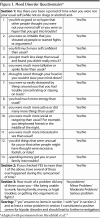The clinical management of bipolar disorder: a review of evidence-based guidelines
- PMID: 22132354
- PMCID: PMC3219517
- DOI: 10.4088/PCC.10r01097
The clinical management of bipolar disorder: a review of evidence-based guidelines
Abstract
Objective: To discuss the criteria used to diagnose the mood episodes that constitute bipolar disorder, the approach to the differential diagnosis of these presentations, and the evidence-based treatments that are currently available.
Data sources: A search for evidence-based guidelines for the diagnosis and treatment of adults with bipolar disorder was performed on May 5, 2010, using the National Guideline Clearinghouse database, the Agency for Healthcare Research and Quality Evidence Reports database, and the Cochrane Database of Systematic Reviews. In addition, a clinical query of the PubMed database (completed March 1, 2010) and searches of drug manufacturers' Web sites (for unpublished trials) were performed to identify randomized, controlled trials and meta-analyses evaluating strategies to treat resistant depression.
Study selection: Guidelines were selected based on data from randomized, controlled trials; meta-analyses; and well-conducted naturalistic trials that were published since 2005.
Data extraction: Four evidence-based treatment guidelines for bipolar disorder were included. Three were published in 2009: those put forth as part of an Australian project, those of the British Association for Psychopharmacology, and those produced by the International Society for Bipolar Disorders and the Canadian Network for Mood and Anxiety Treatments. The most recent US guidelines are that of the Texas Implementation of Medication Algorithms project, last updated in 2005.
Data synthesis: Recommendations from all 4 guidelines were reviewed and are presented with a focus on using them to improve clinical care. The recommendations with the most agreement and highest level of clinical evidence were as follows: (1) mania should be treated first-line with lithium, divalproex, or an atypical antipsychotic medication; (2) mixed episodes should be treated first-line with divalproex or an atypical antipsychotic; (3) bipolar depression should be treated with quetiapine, olanzapine/fluoxetine combination, or lamotrigine; and (4) all patients should be offered group or individual psychoeducation. Additionally, recommendations for therapeutic drug monitoring are presented due to their importance for patient safety, particularly for the primary care physician, although these are based on consensus guidelines.
Conclusions: Bipolar disorder is a lifelong illness that is complicated by high comorbidity and risk of poor health outcomes, making the primary care physician's role vital in improving patient quality of life. The management of acute mood episodes should focus first on safety, should include psychiatric consultation as soon as possible, and should begin with an evidence-based treatment that may be continued into the maintenance phase. Long-term management focuses on maintenance of euthymia, requires ongoing medication, and may benefit from adjunctive psychotherapy.
Similar articles
-
[Antipsychotics in bipolar disorders].Encephale. 2004 Sep-Oct;30(5):417-24. doi: 10.1016/s0013-7006(04)95456-5. Encephale. 2004. PMID: 15627046 Review. French.
-
The future of Cochrane Neonatal.Early Hum Dev. 2020 Nov;150:105191. doi: 10.1016/j.earlhumdev.2020.105191. Epub 2020 Sep 12. Early Hum Dev. 2020. PMID: 33036834
-
Canadian Network for Mood and Anxiety Treatments (CANMAT) and International Society for Bipolar Disorders (ISBD) 2018 guidelines for the management of patients with bipolar disorder.Bipolar Disord. 2018 Mar;20(2):97-170. doi: 10.1111/bdi.12609. Epub 2018 Mar 14. Bipolar Disord. 2018. PMID: 29536616 Free PMC article.
-
Treatments for late-life bipolar disorder.Am J Geriatr Pharmacother. 2006 Dec;4(4):347-64. doi: 10.1016/j.amjopharm.2006.12.007. Am J Geriatr Pharmacother. 2006. PMID: 17296540 Review.
-
Canadian Network for Mood and Anxiety Treatments (CANMAT) guidelines for the management of patients with bipolar disorder: update 2007.Bipolar Disord. 2006 Dec;8(6):721-39. doi: 10.1111/j.1399-5618.2006.00432.x. Bipolar Disord. 2006. PMID: 17156158
Cited by
-
Chronic treatment with anti-bipolar drugs causes intracellular alkalinization in astrocytes, altering their functions.Neurochem Res. 2012 Nov;37(11):2524-40. doi: 10.1007/s11064-012-0837-7. Epub 2012 Jul 28. Neurochem Res. 2012. PMID: 22965852 Review.
-
Diagnosis and treatment of patients with bipolar disorder: A review for advanced practice nurses.J Am Assoc Nurse Pract. 2015 Sep;27(9):530-42. doi: 10.1002/2327-6924.12275. Epub 2015 Jul 14. J Am Assoc Nurse Pract. 2015. PMID: 26172568 Free PMC article. Review.
-
Opportunities for digital health technology: identifying unmet needs for bipolar misdiagnosis and depression care management.Front Digit Health. 2023 Sep 12;5:1221754. doi: 10.3389/fdgth.2023.1221754. eCollection 2023. Front Digit Health. 2023. PMID: 37771820 Free PMC article.
-
Lithium as add-on to quetiapine XR in adult patients with acute mania: a 6-week, multicenter, double-blind, randomized, placebo-controlled study.Int J Bipolar Disord. 2014 Nov 8;2:14. doi: 10.1186/s40345-014-0014-9. eCollection 2014. Int J Bipolar Disord. 2014. PMID: 25505693 Free PMC article.
-
Second Generation Antipsychotics and Cardiovascular Adverse Effects: Developing Evidence-Based Recommendations for Primary Care Medicine.HCA Healthc J Med. 2024 Dec 1;5(6):641-648. doi: 10.36518/2689-0216.1689. eCollection 2024. HCA Healthc J Med. 2024. PMID: 39790698 Free PMC article.
References
-
- Judd LL, Akiskal HS. The prevalence and disability of bipolar spectrum disorders in the US population: re-analysis of the ECA database taking into account subthreshold cases. J Affect Disord. 2003;73(1–2):123–131. - PubMed
-
- Akiskal HS. Validating ‘hard’ and ‘soft’ phenotypes within the bipolar spectrum: continuity or discontinuity? J Affect Disord. 2003;73(1–2):1–5. - PubMed
-
- Soares JC, Gershon S. The diagnostic boundaries of bipolar disorder. Bipolar Disord. 2000;2(1):1–2. - PubMed
-
- Baldessarini RJ. A plea for integrity of the bipolar disorder concept. Bipolar Disord. 2000;2(1):3–7. - PubMed
LinkOut - more resources
Full Text Sources
Molecular Biology Databases

